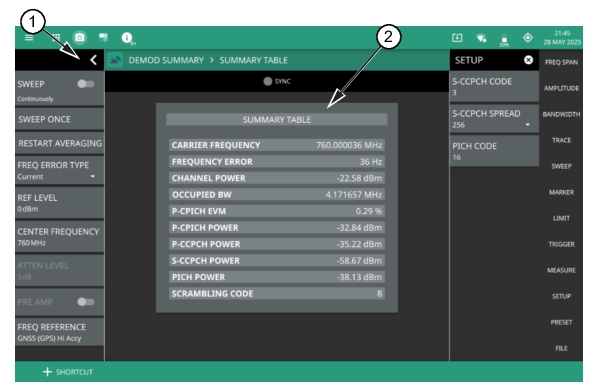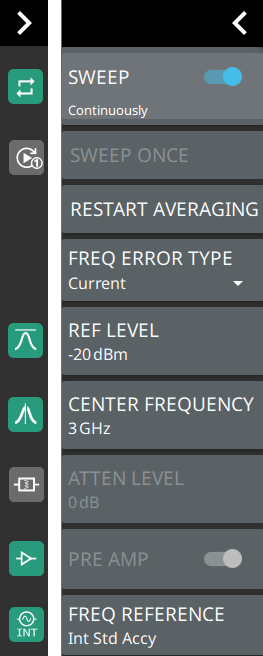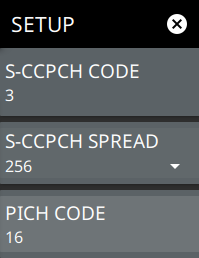 |
1. WCDMA Analyzer Status Panel: Each measurement features a unique status panel that displays settings and information relevant to the current measurement and view settings. This panel provides quick access to the sweep setting, center frequency and reference level. See STATUS PANEL (WCDMA Demod Summary). 2. SYNC: This section consists of primary scrambling code, code group, frequency error and a sync status. 3. Frequency Error: This section shows the frequency error of all the measured signals. It is the difference between the measured carrier frequency and the specified carrier frequency. This measurement is only as accurate as the frequency reference that is used and is typically only useful with a good external frequency reference or GNSS (GPS). It consists of the following data: • Count: The total number of frequency measurements included in the averaging measurement. • Average: The average value of all frequency measurements made. • Standard Deviation: The measure of the spread of frequency measurements. The standard deviation is the average difference of all measurements from the average frequency measurement. Typically 68% of all measurements will fall within the standard deviation value shown. • Minimum: The single lowest frequency value measured. • Maximum: The single highest frequency value measured. 4. Code Domain Power: This section shows the code domain power. It consists of the following data: • CHP: Channel power limit is the amplitude of limit on channel power. • P-CPICH: It is the power of common pilot channel (CPICH) for WCDMA code domain demodulation measurements. • P-CCPCH: It is the channelization code number of the Primary Common Control Physical Channel (P-CCPCH) for WCDMA code domain demodulation measurements. • S-CCPCH: It is the channelization code number of the S-CCPCH channel for WCDMA code domain demodulation measurements. • PICH: It is the channelization code number of the Paging Indicator Channel (PICH) channel for WCDMA code domain demodulation measurements. 5. Code Domain EVM: It is a specific type of EVM measurement that assesses the modulation quality of the signal across individual code channels section. It is represented as the percentage of P-CPICH EVM power. 6. Setup Menu: The setup menu includes S-CCPCH code, S-CCPH spreading factor drop-down and PICH code. See SETUP MENU (WCDMA Demod Summary). |


